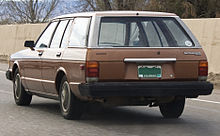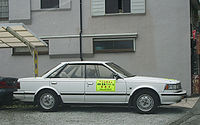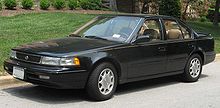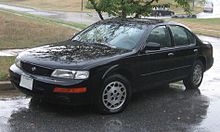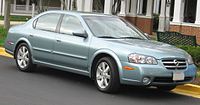- Nissan Maxima
-
Nissan Maxima 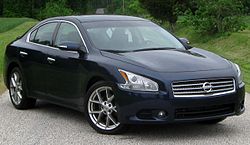
Manufacturer Nissan Model years 1977–present Predecessor Datsun 810
Datsun 200BClass Compact (1976–1988)
Mid-size (1989–2008)
Full-size (2009–present)- For the car known as the Nissan Maxima in Australia, see Nissan Teana
The Nissan Maxima is a full-size car manufactured by Nissan, marketed as the "four-door sports car". The Maxima debuted in July 1976 as an upscale version of the Bluebird and was spun into its own line in 1981, having been made continuously since then. Most pre-2004 Maximas were built in Oppama, Japan, until the current North American Maximas started being assembled in Smyrna, Tennessee.
The Maxima models are also known as Nissan Cefiro or Nissan Laurel in various markets.
Contents
1977–1980
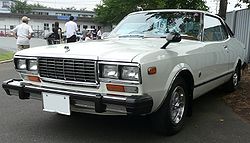
Also called Datsun 810 Model years 1976–1980 Body style 2-door coupe
4-door sedan
4-door station wagonLayout FR layout Engine 2.0 L L20 I6
2.4 L L24 I6Transmission 5-speed manual or 3-speed automatic Related Datsun 280ZX
Nissan BluebirdThe Maxima model line began with the Nissan Bluebird Maxima, which was available in the US as the Datsun 810 from February 1977. It was powered by two versions of the SOHC L-series I6 engine, a 2.0 L displacement for the Japanese market and a 2.4 L (as found in the Datsun 240Z) for the US market. The Bluebird Maxima used a carburetor for the base model and fuel injection for the sporty version. The 2.0 L engine was good for 122 PS JIS (90 kW), while the bigger American engine could reach 125 hp SAE (93 kW). The sporty version channeled power through a four speed manual transmission. These cars were rear-wheel drive and had a semi-trailing arm rear suspension. The station wagon variant had the rear live axle for load carrying reasons.
The 2-door coupe version was introduced in 1979 along with an exterior refresh, and was available in the Maxima lineup in the Datsun 810 only. The new Datsun 280ZX shared the 810's chassis, though the 810 was not available with that car's larger 2.8 L engine.
1981–1984
First generation 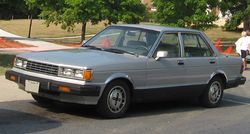
Also called Datsun 810 (until 1983) Model years 1981–1984 Body style 4-door sedan
5-door station wagonLayout FR layout Engine 2.4 L L24E I6
2.8 L Diesel LD28 I6Transmission 5-speed manual
4-speed Jatco E4N71 automaticRelated Nissan Bluebird 910 The first car to wear the Maxima name was introduced in 1981. It was essentially a Japanese-market Bluebird 910 with a 3.9 in (99 mm) longer nose. The car was offered as the 810 Deluxe or 810 Maxima that first year, and all 810s became Maximas for 1982. In 1984, the last year of the first generation Maxima, American Datsuns began carrying the "Nissan" badge as well (only 1984 Nissans have both "Nissan" and "Datsun" on the back of the car). Toyota responded to the introduction of the Maxima by giving the Toyota Mark II a more upmarket sibling, the Cressida.
The second generation retained the same base engine as the previous Datsun 810 and Datsun 240Z. It was also available with the LD28 OHC 2.8L I6 Diesel engine (available in the US from mid-1981 through 1983) with either 5 speed manual or automatic transmission.
Some of the power steering pumps were sourced from General Motors' Saginaw Gear division, while others were sources from Atsugi. This was the second Nissan to use US-sourced parts besides the Borg-Warner T-5 transmission used in the 82-89 Nissan ZX Turbos.
One interesting fact about this car is its phonograph-based voice warning system. Warnings like those for a door being open, etc. would be relayed through the mini phonograph and played for the driver to hear. A common thing to hear would be, "door is open, key is in ignition." 1981 models were the first 'talking car' sold in the US and offered only one voice warning, a female voice reminding the driver to "Please turn off the lights".
1985–1988
Second generation 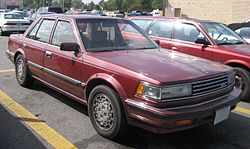
Model years 1985–1988 Assembly Oppama, Japan Body style 4-door sedan
4-door station wagonLayout FF layout Engine 3.0 L VG30E 157 hp (117 kW) V6 Transmission 5-speed manual
4-speed automaticWheelbase Sedan: 100.4 in (2,550 mm)
Wagon: 100.3 in (2,548 mm)Length Wagon: 184.8 in (4,694 mm)
Sedan: 181.5 in (4,610 mm)Width 66.5 in (1,689 mm) Height Sedan: 54.7 in (1,389 mm)
Wagon: 55.7 in (1,415 mm)Related Nissan Bluebird U11 In the fall of 1984, the first front-wheel drive Maxima (based on the Bluebird U11) was introduced. This Maxima was available with a 154 hp (119 kW) 3.0 L VG30E V6 engine and a 4-speed automatic or 5-speed manual transmission. In Japan a smaller 2-litre version of this engine was fitted. These engines were shared with the 300ZX/Fairlady and the Japanese market Nissan Cedric /Gloria, and was the first V6 engine to be mass produced in Japan. The second generation was assigned compact status in the US market. This was the last generation to be available as a station wagon, a version which had been offered since the Datsun 810 days.
In late 1986, the 1987 Maxima was introduced with a freshened exterior and interior. Automatic shoulder belts were now found on both the 1987 sedan and wagons built after February 1987. Luxury amenities were offered on both the "base" GL, later renamed GXE and SE trim levels. Such features for the GL/GXE included digital touch entry system on the driver and passenger side door panel, power windows, locks, antenna, power seats, remote trunk release, voice warning system, optional leather seating, an optional Electronics Pkg (a sedan exclusive, it included a digital instruments and a trip computer) and an optional power sunroof (sunroof was standard on Maxima wagons). 15" alloy wheels are standard for the Maxima. An exclusive option for 1988 was the Sonar Suspension System -which was part of the Electronics Pkg- replacing the trip computer that was previously offered. This feature used sonar waves to monitor the road conditions ahead and adjusted the shocks accordingly for the most controlled ride. 1988 was also the year that the previously standard digital touch system offered on the GXE sedan became part of the 'Electronics Package' option as well. The SE (and some GXEs) offered dual power seats, a five-speed manual transmission, three-way shock adjust suspension, front and rear windshield defroster, and a factory-installed security system. The SE also has a small rear spoiler, all-wheel disc brakes, black side rear view mirrors, and body molding (GXE got body-color side rear-view mirrors and matching body molding). Again, the Maxima's prime competitor was the similarly specified Toyota Cressida, which remained rear wheel drive. The Maxima provided a combination of luxury and sporty features while the Cressida was generally seen as being softer and more luxurious.
The Japanese market "Bluebird Maxima" received a four-door hardtop bodywork and a two-litre V6 engine (with an available turbocharger). Neither the pillared sedan nor the station wagon bodywork were available there.
1989–1994
Third generation 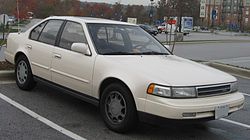
Model years 1989–1994 Assembly Oppama, Japan Body style 4-door sedan Layout FF layout Engine 3.0 L VG30E V6
3.0 L VE30DE V6Transmission 5-speed manual
4-speed automaticWheelbase 104.3 in (2,649 mm) Length 187.6 in (4,765 mm) Width 69.3 in (1,760 mm) Height 1989-91: 55.1 in (1,400 mm)
1992-94: 53 in (1,346 mm)The Maxima was redesigned in 1989 as the J30 (not to be confused with the unrelated Infiniti J30) model. Bigger dimensions made it the second Japanese sedan sold in the USA to qualify as a "mid-size" (after the Mazda 929); it was also the first Japanese car to exceed Japan's 67 in (1,701.8 mm) width restriction, making it fairly comfortable for three rear seat passengers. Surprisingly, weight actually decreased slightly from the former generation. Nissan called the new Maxima a 4-Door Sports Car and even gave it a "4DSC" window decal showing this. It now featured a 160 hp (119 kW) 3.0 L V6, with a 190 hp (142 kW) VE30DE engine standard on the SE model starting in 1992. The VG30E was an engine that had been used in the previous Maxima, as well as the first generation Nissan 300ZX. An interesting feature was the digital touch entry system on the GXE (in conjunction with the new Luxury Package), which allowed the windows to be lowered and the moon roof opened without the key in the ignition. In the United States, the VG30E engine, which featured a variable intake manifold on both automatic and manual transmission models, was used on all 1989–1994 GXE models and 1989–1991 SE models. This generation Maxima was fitted with an independent rear suspension.
The VE30DE engine, which was exclusively offered on the 1992–1994 Maxima SE, featured a variable intake manifold (5-speed model only) and variable intake valve timing, plus a limited-slip differential. The SE models can be further distinguished from the GXE by their white-faced gauges, twisted-spoke turbine wheels (.5 inch wider than GXE wheels), body-colored grille, twin-tip mufflers, factory-tinted tail lights, black trim replacing chrome, firmer sport suspension, and optional 5-speed manual transmission. The automatic transmission on all GXEs (RE4F02A) was an innovative compact unit from Jatco, which featured 'sport' and 'comfort' modes that shifted at different points. The 1992–1994 SE received an optional automatic transmission (RE4F04V) that had stronger internals, but kept the 'sport' and 'comfort' modes. The SE also had a rear spoiler and black side mirrors, whereas the GXE has body-color side mirrors.
During this year, the Maxima was first introduced to the European market, replacing the Laurel. For European markets, the model range was: 3.0, 3.0 S, and 3.0 SE.
All Australian variants had automatic transmissions and the VG30E Engine only. Versions sold in Japan, Europe, and New Zealand had manual transmission option as an alternative to the automatic transmission that was standard in North America and Australia. The Maxima SE was on Car and Driver magazine's Ten Best list for 1990.
Another Bluebird Maxima continued on as a Nissan Bluebird U12 and solely as a station wagon with the VG20ET engine during this period until the introduction of the Nissan Bluebird U13, and the Avenir replaced the Bluebird wagon altogether.
1995–1999
Fourth generation 
Also called Nissan Cefiro (A32) Model years 1995–1999 Assembly Oppama, Japan Body style 4-door sedan Layout FF Engine 3.0 L VQ30DE Transmission 5-speed manual
4-speed automaticWheelbase 106.3 in (2,700 mm) Length 1997-99: 189.4 in (4,811 mm)
1995-96: 187.7 in (4,768 mm)Width 69.7 in (1,770 mm) Height 55.7 in (1,415 mm) Curb weight 2,870 lb (1,300 kg) Related Infiniti I30 The car was redesigned again in 1995 as the A32. A new VQ30DE 190 hp (141 kW), 205 lb·ft (278 N·m) tq 3.0 L V6 was the only engine option for the North American market. The VQ30DE earned a first spot on the Ward's 10 Best Engines List, and the VQ has now been recognized consecutively for every year since its introduction (as of 2008, 14 years running).[1] The independent rear suspension of the previous generation was replaced with a lighter and cheaper torsion bar solid axle system.
The Maxima's primary competitor, the Toyota Cressida, was discontinued after the 1992 model year, with Toyota touting the FWD Toyota Avalon, a stretched version of the Toyota Camry introduced in 1994, as its replacement.
The exterior was refreshed for 1997, with new 5-spoke alloy wheels, plastic (clear-lens) headlights vs. the previous glass headlights, a slightly different front and rear fascia with new redesigned tail-lights, the rear-facing part of the trunk was smoothed out to match the tail-lights, re-designed fog-lights and badge designs, and a chrome grille insert for GLE's (body color for SE models) was added. Among interior changes were a different steering wheel and CD player. Front seat-mounted side impact airbags were added as an option for 1998 and 1999 SE and GLE models. There were also structural modifications to improve crash worthiness for the 1997 to 1999 models. The 1999 Nissan Maxima also saw some minor changes: an Anti-Theft Engine Immobilizer was standard using a chip in the ignition key, as well as the '99 Maxima actually had some minor body trims. The '99 Maxima was the only 4th Generation offered with optional traction control.
The 1999 Maxima SE was also available with a Limited Package which consisted of Titanium tinted SE-Limited emblems on the front doors, titanium tinted trunk emblems, and titanium tinted 16" alloy wheels. The interior gauge cluster was also titanium tinted and the optional leather seats were preforated and embossed with SE on the backrests. The front floor mats were also embossed with SE-Limited logos.
The North American 1995 Maxima included a Bose Sound System on the GLE (optional on the SE) which had a 6 speaker sound system, a Clarion system was also an option (non-Bose). The fourth generation Maxima was highly praised for its roomy interior.
This Maxima was Motor Trend's Import Car of the Year for 1995. The Maxima SE again made Car and Driver magazine's Ten Best list for 1995 and 1996.
The 1995 VQ30DE (3.0 litre) engine produced 190 hp (142 kW) and 205 lb·ft (278 N·m) of torque. With the manual transmission 0-60 mph took 6.7 seconds with a quarter mile time of 15.2-seconds at 92.4-mph.
A top-of-the-line 1995 Maxima GLE equipped with a four-speed automatic transmission turned in a 7.5-second 0-60-mph run with a 15.6-second/89.4-mph quarter mile time.[2]
The Maxima was one of the few 4 door, V6 cars at the time with an option for a manual transmission (as opposed to the automatic-only Toyota Avalon, Mazda Millenia, Chevrolet Lumina, Dodge Intrepid, etc.).
This particular generation was sold in Japan as the Nissan Cefiro A32, which previously had been its own higher specification model with rear-wheel drive car (see A31 Cefiro). For the Japanese market, a Cefiro-badged station wagon was also available. One version of the Cefiro (Brougham VIP spec) was sold in the US as the Infiniti I30, yet the Cefiro had subtle differences including different fog light arrangements, one-piece headlights and a few assorted engine options (VQ20/25/30DE).
This generation was also sold as the Maxima QX in Europe and other parts of the world, and was mostly identical to the Japanese Cefiro except for minor trim differences.
2000–2003
Fifth generation 
Also called Nissan Cefiro (A33) Model years 2000–2003 Assembly Yokosuka (Oppama), Japan
Tehran, Iran (Pars Khodro)Body style 4-door sedan Layout FF layout Engine 3.0 L VQ30DE-K - 222-227 hp, 217TQ V6
3.5 L VQ35DE - 255 hp (190 kW), 245TQ V6Transmission 4-speed automatic
5-speed manual
6-speed manualWheelbase 108.3 in (2,751 mm) Length 2000-01: 190.5 in (4,839 mm)
2002-03: 191.5 in (4,864 mm)Width 70.3 in (1,786 mm) Height 2000-01: 56.5 in (1,435 mm)
2002-03 GXE: 56.3 in (1,430 mm)
2002-03 SE: 56.7 in (1,440 mm)
2002-03 GLE: 57.1 in (1,450 mm)Curb weight 3,245 lb (1,472 kg) Related Infiniti I30/I35 The 2000 Maxima (designated A33) was a refresh of the previous car, designed at Nissan's La Jolla, California design studio. Often associated with being the fastest years of the Maxima, the engine was a 222 hp (166 kW) (227 hp SE) 3.0 L VQ30DE V6. This variant of the VQ30DE was referred to the VQ30DE-K. In this variation, there were three models (GXE, GLE, and SE). The "GXE" was the base Maxima. The GLE was the "luxury" variant and had 16 inch wheels. This generation was used for the Infiniti I30, (JDM Nissan Cefiro).The 2001 Maxima is the special edition of the SE model which commemorates the 20th anniversary of this particular Nissan. In addition to the usual SE content, this car has the Infiniti I30’s engine, special side skirts (ground effects) all around the lower perimeter, and a few special touches to the interior. The last addition includes drilled metal “brushed metallic” pedals, a “brushed metallic” shifter, and stainless steel door sill plates that has the name Nissan Maxima. The optional leather is perforated, unlike that in the regular SE. Finally, the "SE Comfort and Convenience Package" which includes a sunroof, 17" wheels, and a few other things is standard. Since the 20th Anniversary Edition lists for $27,149, which is $3,300 more than the regular SE, you’re paying $1,500 for the unique content the 20th Anniversary Edition has to offer the Nissan driving enthusiasts. The fifth-generation Maximas have a number of common problems: ignition coils, MAF sensor, TPS (Throttle position sensor) and IACV-AAC (Idle control valve).[citation needed] Users should be particularly aware of the IACV problem which can short out the ECM leading to a very costly repair.[citation needed] All of these faults trigger the check engine light.[citation needed]
In 2002, the engine was replaced for the whole lineup with a 3.5 L VQ35DE that produced 255 hp (190 kW) and 246 lb·ft (334 N·m) of torque. In addition, the model got a slight refresh with a larger grille opening, headlamps with high-intensity discharge (HID) low beams, a six-speed manual transmission with optional helical Torsen limited-slip differential, revised 17 inch six-spoke wheels on the SE models, new 17 inch seven spoke wheels on the GLE models, clear taillights, and some interior and exterior refinements over the 2000 to 2001 models. In 2003, there was a special package called the Titanium Edition with special wheels and interior treatment, as well as a Meridian Edition package which included heated seats and steering wheel (most of the time leather, although some were available with heated cloth), and a GPS navigation system. The Titanium Edition was available in all colors, but a new color was available only with the Titanium Edition (Polished Titanium). The last generation Maxima was the basis for the Infiniti I35. In Russia and Europe, the Maxima is being sold as Nissan Maxima QX.
2004–2008
Sixth generation 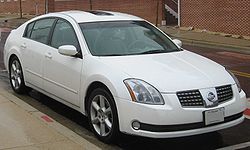
Model years 2004–2008 Assembly Smyrna, Tennessee, USA Body style 4-door sedan Layout FF layout Platform Nissan FF-L platform Engine 3.5 L VQ35DE V6 Transmission 6-speed manual
4-speed automatic
5-speed automatic
CVT (Ratios: 2.371-0.439)Wheelbase 111.2 in (2,824 mm) Length 2004-2006: 193.5 in (4,915 mm)
2007-2008: 194.4 in (4,938 mm)Width 71.7 in (1,821 mm) Height 58.3 in (1,481 mm) Related Nissan Altima
Nissan Teana
Nissan Murano
Nissan QuestThe sixth generation Maxima, code-named A34, was only sold in the United States, Canada and Mexico. In the US, it came with the venerable VQ35DE, a DOHC V6 engine that produced 265 hp (198 kW) at 5,800 rpm, and 255 lb·ft (346 N·m) of torque at 4,400 rpm and a standard SkyView fixed glass paneled roof that ran down the center of the roof (from front to back) or an optional traditional style moonroof. Sixth generation Maximas were available in two trim levels, SE and SL. The sporty SE model came standard with 18 inch alloy wheels, P245/45R18 V-rated tires, stiffer suspension, rear spoiler, and an optional 6-speed manual transmission. The luxurious SL model came standard with 17 inch alloy wheels, P225/55R17 H-rated tires, wood interior trim, 6-disc CD changer, Bose stereo, leather seats, and HID headlights. The manual transmission was never offered in the SL model and the suspension is tuned for a softer ride. For all models, the rear independent suspension returned, this time using a multilink setup similar to the Altima.
For 2007, the U.S. Maxima became available with a standard Xtronic CVT (Continuously Variable Transmission) (similar to the CVT found in the Nissan Murano) as the only transmission choice; a manual transmission was no longer offered; however the CVT featured a manual mode. It featured a freshened front fascia (lacking the center block, the new grille closely resembled that of the 2007 Altima). Headlights were also more squared around the edges. New interior changes included an Intelligent Key system with integrated ignition tab, new center console, and new white-and-orange gauges as opposed to the older pure orange ones.
For 2008, the Maxima's fuel economy dropped from 21MPG-City / 28MPG-Highway to 19/25 due to new EPA measurement methods. A Platinum Edition package of convenience features was added for 2008 on both SE and SL trim levels.
In Australia, the Maxima had the same engine, but Nissan set the maximum power to only 170 kW (228 hp). The Australian version was code-named J31, shared the VQ engine, initially only came with a four-speed automatic transmission, and had quite noticeable styling differences to the North American version as it was based on the Nissan Teana. In 2007, it received a minor mid-life facelift and an all new CVT automatic transmission.
In Hong Kong, Bangladesh, Singapore, Brunei, Latin America & the Caribbean, it was sold as the Nissan Cefiro. It was built on the standard FF-L platform of the Altima/ US Maxima combined with certain pieces of the JM Nissan Presage design same as the Nissan Teana previously mentioned. The American Maxima was known for a balance between sport and luxury; other models tended to focus more on comfort.
2009–present
Seventh generation 
Also called Nissan Maxima A35 Production 2008–present Model years 2009– Assembly Smyrna, Tennessee, USA Body style 4-door sedan Layout FF layout Platform Nissan D platform Engine 3.5L VQ35DE V6 Transmission CVT (Ratios:2.371-0.439) Wheelbase 109.3 in (2,776 mm) Length 190.6 in (4,841 mm) Width 73.2 in (1,859 mm) Height 57.8 in (1,468 mm) Curb weight 3,565 lb (1,617 kg) Related Nissan Altima
Nissan TeanaThe Maxima was redesigned for the 2009 model year and made its debut at the 2008 New York International Auto Show. The newest Maxima (A35) is built on the Nissan D platform sharing this platform with the fourth generation Nissan Altima and second generation Nissan Murano. The exterior and interior design are somewhat similar to the Infiniti G and Infiniti M, with an updated navigation interface and optional USB interface system that works with the main console monitor and steering wheel controls. It comes equipped with a revised version of the VQ35DE engine producing 290 horsepower (220 kW) and 261 lb·ft (354 N·m) of torque. A revised version of Nissan's Xtronic CVT (Continuously Variable Transmission) with paddle shifting is the only transmission offered (no manual).[3] A diesel version was expected to be released for the 2010 model year, although those plans were not realized.[4] The new Maxima is offered in S and SV trims with several premium and technology packages available. The current Maxima's design trades height and length for a sleeker styling, although the width has been increased slightly. The keyless ignition uses a push button to start and stop the engine . In the U.S., the seventh generation Maxima went on sale in late June 2008.
Performance:[5]
- 0–60 mph: 5.1 sec.
- Skid Pad Lateral acceleration: 0.85 g
- 1/4 Mile: 14.5 sec. @ 98 mph (158 km/h)
- 60–0 mph: 128 feet (39 m)
Models
The Maxima comes in several versions:
3.5 S: Includes 3.5L, 290-Horsepower V6 Engine, CVT (Continuously-Variable Transmission), Intelligent Key System w/ Push-Button Start, A/M-F/M Stereo w/ Six-Disc CD/MP3 Changer, Aux Jack, w/ Bluetooth Telephone, w/ Eight Speakers, Eighteen-Inch Alloy Wheels, Sliding Power Moonroof
3.5 SV: Includes Leather interior, A/M-F/M Stereo w/ Six-Disc CD/MP3 Player, Aux Jack, w/ Bluetooth Telephone, w/ Voice Recognition System, w/ Premium Bose Surround-Sound Speaker System, w/ XM Satellite Radio
3.5 SV w/ Premium Package: Includes Nissan Music Box w/ On-Board HDD and Navigation System w/ XM Traffic & Weather, iPod/USB Input Jacks
3.5 SV w/ Sports Package (Adds to Base 3.5 SV Features): Nineteen-Inch Alloy Wheels, iPod/USB Input Jacks
3.5 SV w/ Premium & Sports Packages (Adds to 3.5 SV Premium Package Features): Nineteen-Inch Alloy Wheels
Awards and recognition
2009
- ALG Residual Value Awards for Best Fullsize Car
2010
- AutoPacific Best in Class Vehicle Satisfaction Award
- ALG Residual Value Awards for Best Fullsize Car
2011
- ALG Residual Value Awards for Best Fullsize Car[6]
- Fatherhood Award™ from the National Fatherhood Initiative (NFI) for the television commercial “Baby”[7]
See also
References
- ^ "Nissan Maxima awards and reviews". Nissanusa.com. http://www.nissanusa.com/maxima/awards.html. Retrieved 2010-10-12.
- ^ "motor trend '95 nissan maxima se from http://www.nissanx.com/old/htdocs/mt1.html - 4 door 3 litre (2998 cc) V6 192.6 PS, 4 speed automatic". www.nissanx.com. http://www.nissanx.com/old/htdocs/mt1.html. Retrieved 2011-04-02.
- ^ "2009 Nissan Maxima". http://www.autoblog.com/2008/03/19/new-york-2008-nissan-unveils-2009-maxima-with-liquid-motion-s/.
- ^ "2010 Nissan Maxima to have diesel option.". http://www.autoblog.com/2007/04/18/nissan-will-sell-diesel-maxima-in-u-s-by-2010/.
- ^ "2009 Nissan Maxima SV - Road Test - Sept 2008". http://www.caranddriver.com/reviews/hot_lists/car_shopping/family_four_doors/2009_nissan_maxima_sv_road_test/.
- ^ http://www.nissanusa.com/maxima/awards.html
- ^ http://www.nissannews.com/newsrelease.do;jsessionid=167470A2290F0E847B1D5FD48839F8CA?&id=2592&allImage=1&teaser=national-fatherhood-initiative-honors-nissan-fatherhood-award&mid=1
- "Datsun 810 and Nissan Maxima". Edmunds.com. http://www.edmunds.com/reviews/generations/articles/104713/article.html. Retrieved March 25, 2005.
- "New photos of Nissan Maxima". http://www.autoblog.com/2008/03/18/new-york-08-preview-2009-nissan-maxima-leaked-on-forum/.
- "2011 Nissan Maxima Specifications". http://www.nissanusa.com/maxima.
External links
Nissan Motor Company Vehicles Current370Z • Advan • Altima • Aprio • Armada • Atlas • Bluebird • Bluebird Sylphy • Cabstar • Caravan • Civilian • Clipper • Cube • Dualis • Elgrand • Frontier • Freeson • Fuga • GT-R • Juke • Lafesta • Leaf • Livina Geniss • Maxima • March • Murano • Moco • Navara • Note • NV200 • NV400 • Otti • Paladin • Pathfinder • Patrol • Qashqai • Quest • Rogue • Safari • Sentra • Serena • Skyline • Teana • Tiida • Titan • Urvan • Versa • Wingroad • X-Trail • XterraPastDC-3 • 100NX • 1200 • 310 • 180SX • 200SX • B-210 • 240SX • 240Z • 280ZX • 300C • 300ZX • 350Z • 510 • 810 • Almera • Almera Tino • Altra (EV) • Avenir • Auster • Bassara • Be-1 • Caball • Cablight • Cedric • Cefiro • Cherry • Cima • Crew • Datsun Truck • Echo • Expert • Fairlady • Figaro • Gazelle • Gloria • Hardbody Truck • Hypermini • Homy • Interstar • Junior • Largo • Laurel • Leopard • Liberty • Mistral • Multi • NX • Pao • Pintara • Pino • Platina • Prairie • Presage • Presea • Primera • President • Pulsar • Pulsar GTI-R • R390 GT1 • R'nessa • Rasheen • Roadster-Road Star • S-Cargo • Saurus • Saurus Jr • Silvia • Sileighty • Skyline GT-R • Stanza • Stagea • Sunny • Terrano • Terrano II • Vanette • VioletConcept126X • 216X • 270X • 300 Bambu • 315-a • AA-X • Actic • AD-1 • AD-2 • AL-X • Alpha T • Amenio • AQ-X • AP-X • ARC-X • AXY • AZEAL • Bevel • Boga • C-Note • Chapeau • Chappo • Cocoon • CQ-X • Crossbow • CUE-X • Cypact • Duad • Dunehawk • Effis • ESV • Evalia • EV Guide II • EV Truck • FEV • FEV-II • Foria • Forum • Fusion • Gobi • GR-1 • GR-2 • GT-R • ideo • Intima • Jikoo • Judo • Jura • Kino • KYXX • Land Glider • LEAF • LUC-2 • MID4 • Mixim • mm.e • Moco • Nails • NCS • NEO-X • NRV-II • NX-21 • NV2500 • Pivo • Pivo 2 • Qazana • Redigo • Round Box • Serenity • Sport Concept • Stylish VI • Terranaut • Tone • Townpod • Trailrunner • TRI-X • URGE • UV-X • XIX • XVL • Yanya • ZarootEngines GRX-3 • UD12 • VRT35Marques Nissan • InfinitiSubsidiaries
and divisionsSee also ATTESA • Datsun • HICAS • Prince • Renault-Nissan Alliance • Nissan Shatai • UD Nissan Diesel • VVL • VVEL • dCi
Nissan road car timeline, United States and Canadian markets, 1980s–present Type 1980s 1990s 2000s 2010s 0 1 2 3 4 5 6 7 8 9 0 1 2 3 4 5 6 7 8 9 0 1 2 3 4 5 6 7 8 9 0 1 2 Subcompact Micra 210 Sentra Sentra Sentra Sentra Versa Versa Compact 310 Sentra Sentra 510 Stanza Stanza Stanza Altima Altima Leaf 810 Maxima Maxima Mid-size Altima Altima Maxima Maxima Maxima Maxima Full-size Maxima Sport compact Pulsar NX Pulsar NX NX 200SX 200SX 200SX 240SX 240SX Sports 280ZX 300ZX 300ZX 350Z 370Z GT-R (R35) Categories:- Nissan vehicles
- 1970s automobiles
- 1980s automobiles
- 1990s automobiles
- 2000s automobiles
- 2010s automobiles
- Coupes
- Front wheel drive vehicles
- Mid-size cars
- Rear wheel drive vehicles
- Vehicles with CVT transmission
- Sedans
- Sports sedans
- Station wagons
- Vehicles introduced in 1976
- Motor vehicles manufactured in the United States
- Executive cars
Wikimedia Foundation. 2010.

